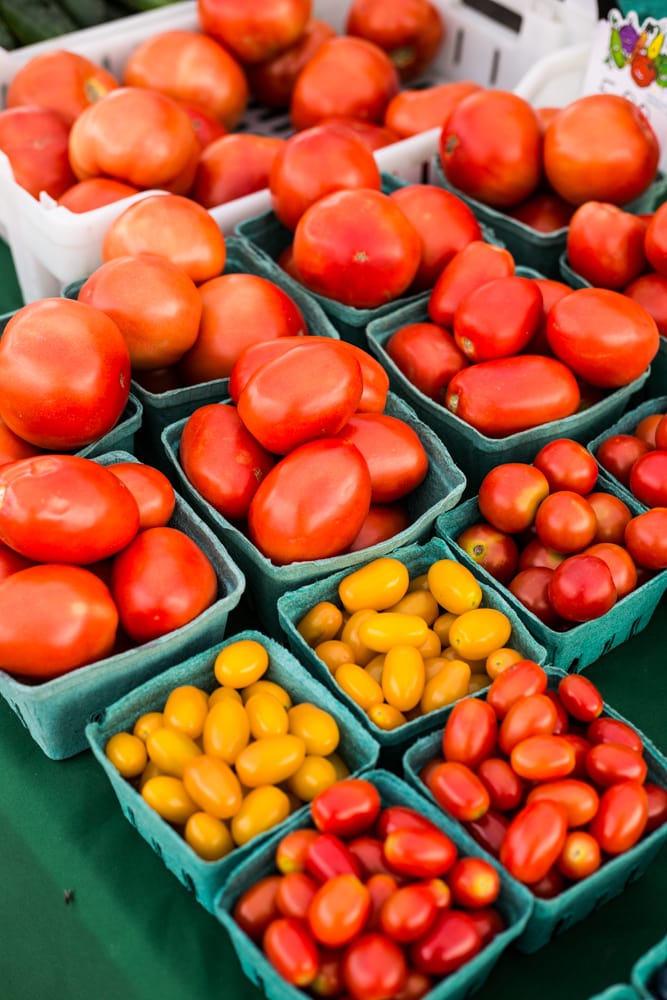Nothing beats summer’s bounty! This Summer Produce Guide outlines where to source the freshest produce and how to select, store, and clean it!
When it comes to eating seasonally, no time is better than the summer. Markets are brimming with freshly picked, vibrantly hued, and sun-ripened summer produce.
Densley green zucchini, snappy beans, bushels of herbs, and fat tomatoes in every shade that beg to be purchased and enjoyed that very day. Beautiful produce is abundant this time of year, and I think it best to enjoy it in copious amounts.
However, how do you choose the best produce? Where should you purchase it from? How do you wash it? Where do you store it? In my Summer Produce Guide, I have the answers to all of these questions. Let’s dive in!

Where To Purchase Summer Produce
The produce of the season will be readily available in all markets and grocery stores during this time of year. Tomatoes in your supermarket that were once pink and greenhouse-grown, now likely proudly don a “Local” sticker. It’s a fact that produce (or any good, for that matter) that is grown or made locally will require fewer resources to get into your cart or basket.
For example, corn that was grown in your town will travel a shorter distance than that which was grown two states over. That said, I always opt to purchase my summer produce as locally as possible. Most times, this means my local Farmer’s Market where I’m able to interact with the actual farmer that planted, cared for, harvested, and is selling the literal fruits of their labor.

How To Select The Best Summer Produce
How to select the best summer produce will depend on what you’re shopping for, but a few general notes:
- Weight: your produce should feel heavy for its size. Water makes up a large part of your produce, and with time that moisture diminishes. This inherently impacts the quality and ultimate texture and flavor of your produce, too.
- Appearance: Choose the most vibrantly colored, unblemished, and plump-looking produce. Also, keep an eye out for pests which could be an indication of spoilage.
- Growing Conditions. This can be a personal preference, but I try to purchase produce that has been grown without the use of pesticides. Many growers will designate that they are pesticide, chemical fertilizer, and dye-free. Keep an eye our at your local market. If you’re purchasing in a grocery store, I recommend seeking out produce that is organic, especially when you’re shopping for the infamous Dirty Dozen (see below!).

How To Store Produce
How you store produce will depend on the type of produce you have. While some items store best in the refrigerator, some ripen best on the countertop. See below for how to store a majority of summer produce that you’ll find in the markets this season.
In The Refrigerator
- Carrots
- Cauliflower
- Celery
- Corn (but best enjoyed as quickly after it’s picked!)
- Cucumber
- Peppers
- Beans
- Peapods
- Beets
- Broccoli
- Cabbage
- Kale
- Mushrooms
- Zucchini and Summer Squash
...And In Water!
Asparagus, fresh herbs, and green onions are best stored with their ends in a glass of water.
In A Cool Dark Place
- Garlic
- Onions
- Shallots
- Potatoes
On The Countertop
- Eggplant
- Tomatoes

How To Clean Produce
Once again, how your vegetables are cleaned will depend on the type you’re working with.
Most soft-skinned vegetables, like tomatoes, peppers, and zucchini require a simple rinse and gently rubbing with your fingers. You can opt to use a gentle vegetable wash or a mixture of 1 part white vinegar to 2 parts water as well.
Heartier vegetables, like potatoes, winter squash, and carrots, need more substantial cleaning. I like using a sturdy vegetable brush to remove excess dirt.
Tender greens and lettuces will need a good soak to remove dirt and sand. Fill a large bowl with water and add your greens. Swish them around a little, pull the greens out (don’t drain – the grit is at the bottom of the bowl!), and repeat. This may take a couple times depending on how dirty they are. Use a salad spinner to dry them and use immediately.



Enjoy Summer's Bounty!
I hope this Summer Produce Guide inspires you to enjoy all that this all too short season has to offer. Whether you hit your local Farmer’s Market every week until summer ends, or simply try a new seasonal recipe that features vegetables, get out there and eat your vegetables!
Find this Summer Produce Guide helpful? Check out my “So Happy In The Kitchen” page, where I share helpful roundups of products, ingredient and cooking method education, and recipe tips and tricks!
Don’t forget to check out my YouTube Channel! You can also shop all of my favorites here.

